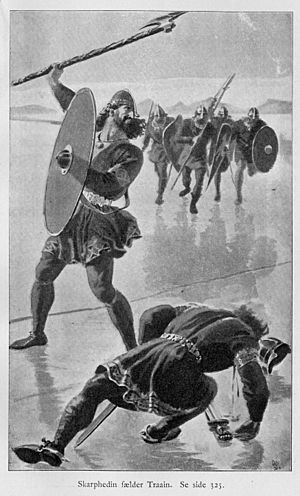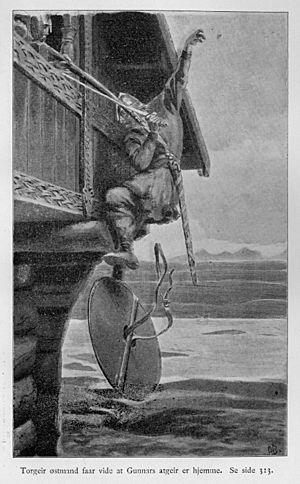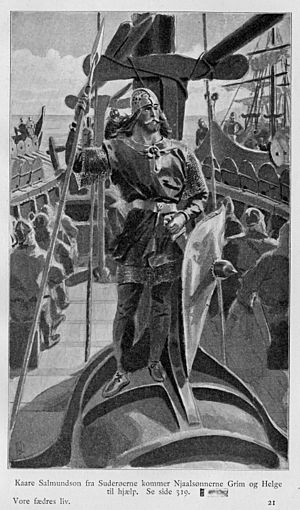Njáls saga facts for kids
Njáls saga (also known as Njála or "The Story of Burnt Njáll") is a famous Icelandic story written in the 1200s. It tells about events that happened in Iceland between the years 960 and 1020.
The story is mostly about blood feuds. These were long-lasting fights between families in the old Icelandic Commonwealth. The saga shows how small disagreements could grow into big, violent conflicts. People felt they had to protect their family's honor. Sometimes, even small insults could lead to serious trouble and many deaths.
The main characters are two good friends: Njáll Þorgeirsson, who is a wise lawyer, and Gunnar Hámundarson, a strong warrior. Gunnar's wife, Hallgerðr langbrók, starts a feud that causes many people to die. This includes Njáll himself, who is tragically killed by fire.
No one knows for sure who wrote Njáls saga. But many of the events in the story are probably based on real history. The author used old stories passed down by word of mouth to create this amazing tale. Njáls saga is the longest and most detailed of all the Icelandic sagas. Many people think it's the best one ever written.
Contents
Who Wrote Njáls Saga?
Just like other Icelandic sagas, the author of Njáls saga is unknown. For a long time, people have guessed who might have written it. Some thought it was Sæmundr fróði or his sons. Others suggested famous people like Jón Loftsson or Snorri Sturluson.
Today, most experts believe the saga was written sometime between 1270 and 1290. The author likely used parts from other sagas that were written down, like Laxdæla saga and Eyrbyggja saga. But most of the story probably came from old tales that people told each other.
The author used these oral stories to create a great work of art. While Njáll and Gunnarr were real people, the saga isn't a history book. It uses historical events to tell an exciting and meaningful story.
Main Ideas in Njáls Saga
Njáls saga explores what happens when people seek revenge to protect their family's honor. It shows how a blood feud can last for 50 years. The saga teaches us how even good people can destroy themselves through arguments. It also shows the problems in the Icelandic Commonwealth that eventually led to its downfall.
In those times, any insult to a person's honor had to be avenged. Sometimes, these insults seem very small to us today. One expert, Magnus Magnusson, said it's "a little pathetic" how easily these men could be pushed into fighting over a suspected insult.
The saga also talks a lot about how men were expected to act. For example, Njáll doesn't have a beard, and his enemies use this to question his manliness. Another time, a gift of a silk shirt is seen as a huge insult. Some scholars believe Njáls saga criticizes how strict and unfair these ideas of masculinity were. It shows how they could hurt men and society.
The story also includes many signs, prophetic dreams, and characters who can see the future. People disagree about how much fate plays a role in the saga. Some think it means everything is planned out from the start. Others believe the characters still have choices, even if things seem to be leading to a certain end.
Story Summary
The saga is a long story, but we can break it down into a few main parts.
Hrútur and Hallgerður's Beginnings
The first part of the story introduces Hrútur Herjólfsson. He travels to Norway and gains honor. But he makes an enemy of Queen Gunnhildr, who curses him. This curse causes problems in his marriage to Unnr. When Unnr divorces him, Hrútur uses a trick to keep her dowry (money or property given at marriage). This is legal but not fair.
Next, we meet Hrútur's beautiful niece, Hallgerður. Hrútur once said she had "thieves' eyes," which hints at trouble. Hallgerður marries twice, and both husbands die by the axe of her foster-father, Þjóstólfr. Hallgerður causes the first death. Hrútur eventually avenges these deaths by killing Þjóstólfr.
Gunnar and Njáll Become Friends

Now, Gunnar Hámundarson and Njáll Þorgeirsson enter the story. Gunnar is very strong and brave, and Njáll is very wise. They become close friends. Njáll helps Gunnar win back Unnr's dowry from Hrútur. Gunnar uses a similar trick to Hrútur's, and Hrútur loses. Even though he's embarrassed, Hrútur sees a future connection with Gunnar.
Gunnar travels to other countries and returns with great honor. He goes to the Althing (Iceland's yearly assembly) and meets Hallgerður. They are very attracted to each other and decide to marry. Both Hrútur and Njáll warn Gunnar about Hallgerður's difficult personality, but he doesn't listen.
Their warnings come true when Hallgerður and Njáll's wife, Bergþóra, start fighting. Hallgerður convinces some bad characters to kill people in Njáll's household. Bergþóra, who is also very spirited, arranges for revenge. After each killing, the husbands make payments to settle the disputes. But one killing involves Þráinn Sigfússon, Gunnar's uncle and Hallgerður's son-in-law. This causes problems later.
Gunnar's Fights and Troubles
Hallgerður then uses one of her slaves to steal from a man named Otkell. Gunnar tries to make things right, but Otkell refuses his offers. A lawsuit starts, and with Njáll's help, Gunnar wins. But Gunnar gets angry at Hallgerður for the theft and slaps her.
Later, Otkell accidentally wounds Gunnar. Gunnar feels insulted and reluctantly goes to get revenge. With help from his brother Kolskeggur, he kills Otkell and his friends.
Njáll helps arrange another peaceful settlement, and Gunnar's fame grows. But Njáll warns him that this is just the start of his troubles.
Next, Gunnar takes part in a horse-fight. His opponents cheat, leading to another fight. Njáll tries to help, but the other side refuses a settlement. Gunnar and his two brothers are ambushed. In the fight, 14 attackers and Gunnar's brother Hjörtur are killed.
Unnr's son, Mörður Valgarðsson, is a sneaky character who hates Gunnar. He learns that Njáll predicted Gunnar would die if he killed twice in the same family and then broke a settlement. Mörður encourages others to attack Gunnar. Gunnar wins the fight, but he kills a second man from the same family. The settlement for this means Gunnar and Kolskeggur must leave Iceland for three years.
As Gunnar leaves his home, he looks back at the beautiful land and decides he can't leave. This makes him an outlaw. He tries to live normally, but his enemies, including Mörður, seek revenge. Gunnar defends his home bravely until his bowstring breaks. Hallgerður refuses to give him her hair to fix his bow, as revenge for the slap he gave her. Gunnar is eventually killed. Njáll's son Skarphéðinn helps Gunnar's son Högni get some revenge before a new peace is made.
Kári and Njáll's Sons
Two groups of Icelanders travel to Scandinavia: Þráinn Sigfússon and Njáll's two younger sons. Both groups return with honor. Þráinn brings back a bad man named Hrappr. Njáll's sons bring back the noble Kári Sölmundarson, who marries their sister.
Njáll's sons are angry because Þráinn hid Hrappr from the ruler of Norway, Jarl Hákon. Njáll tells his sons they were foolish to bring it up, but advises them to make it a matter of honor. Þráinn refuses to settle, and his followers insult Njáll's sons.
Then comes one of the most exciting battles in the saga. Njáll's sons and Kári plan to ambush Þráinn. There's a bridge of ice over a river. Skarphéðinn rushes ahead, leaps the river, and slides on the ice past Þráinn, splitting his skull. The attackers kill four men, including Hrappr.
Þráinn's brother, Ketill, is married to Njáll's daughter. They help arrange a settlement. To prevent more fighting, Njáll adopts Þráinn's son, Höskuldr, as his foster-son. Höskuldr grows up in Njáll's home and is loved by him. When Höskuldr is older, Njáll finds him a wife, Hildigunnr. She says she will only marry him if he becomes a chieftain. Njáll helps Höskuldr become a chieftain, and they marry.
Around this time, the saga mentions that Iceland became Christian in the year 999 CE.
Höskuldr, Flosi, and the Burning
Mörðr Valgarðsson sees that Höskuldr is a very successful chieftain, and his own power is shrinking. He turns Njáll's sons against Höskuldr. Sadly, Njáll's sons, along with Mörðr and Kári, murder Höskuldr while he is working in his field. Everyone is sad about Höskuldr's death, especially Njáll, his foster-father.
Flosi, who is Höskuldr's wife's uncle, seeks revenge. Hildigunnr pushes him to only accept blood revenge, not money. Njáll's sons try to get help at the Althing. Skarphéðinn, however, has become very gloomy and insults many people who might have helped them.
After some legal arguments, people are chosen to help settle the dispute. They decide that Höskuldr's family should receive three times the normal payment for his death. This is a huge amount, so many people at the Althing contribute money. Njáll adds a fancy cloak as a gift. But Flosi feels insulted by the cloak (and by an insult from Skarphéðinn). The settlement falls apart.
Everyone leaves the Althing and prepares for a fight. One hundred men attack Njáll's home, Bergthorsknoll. About thirty people defend the house. Njáll suggests his sons fight from inside the house. They know it's hopeless, but they agree. Flosi and his men then set the house on fire.
Both innocent and guilty people are trapped. Flosi lets the women leave. But when Helgi Njálsson tries to escape dressed as a woman, he is killed. Flosi invites Njáll and Bergþóra to leave, but they refuse. They choose to die with their sons and grandson. In the end, eleven people die. Kári escapes by running along a beam in the burning house. Flosi knows that Kári will get revenge for the burning.
Revenge and Peace
At the next Althing, both sides gather. Flosi hires a skilled lawyer. Njáll's foster-son, Þórhallr, who was trained in law by Njáll, advises the other side. There is a big legal battle. When his case seems to be failing, Þórhallr, who has an infected leg, opens his boil with a spear and starts fighting. Flosi's men are pushed back until Snorri stops the fighting. Several people are killed in the confusion.
Ljótr, Flosi's brother-in-law, is killed. His father, Hallr of Síða, asks for peace and no payment for his son's death. This moves everyone. All but Kári and Njáll's nephew Þorgeir agree to a settlement. Everyone contributes to a payment for Ljótr, which ends up being four times the normal amount. The men who burned Njáll's house are sent into exile.
Before the burners reach home, Kári attacks them. Most of the rest of the saga describes Kári's revenge for the burning. He is helped by Þorgeir and a character named Björn. Kári chases the burners to Orkney and Wales. One dramatic moment is when he breaks into a hall in Orkney and kills a man who is spreading lies about those who died in the fire.
After a trip to Rome, Flosi returns to Iceland. Kári follows him and is shipwrecked near Flosi's home. Kári goes to Flosi for help, testing his honor. They finally make a lasting peace. Kári marries Höskuldr's widow. In the end, there is full reconciliation.
Njáls Saga in Pop Culture
Njáls saga has inspired many modern stories, movies, and other works.
- Books: Many novels have been written based on the saga's plot. These include Fire in the Ice (1961), The Burning of Njal (1964), and Thief Eyes (2011).
- Poems and Plays: Poets like Thomas Gray and Jónas Hallgrímsson wrote works inspired by the saga. There are also plays, such as The Riding to Lithend (1909).
- Comics: A graphic novel (comic book) version of the saga was published in Iceland between 2003 and 2007.
- Film, TV, and Radio:
* An Icelandic short film called Brennu-Njálssaga (The Saga of Burnt Njal) was made in 1981. * The 1995 adventure film The Viking Sagas is also inspired by the story. * An episode of Monty Python's Flying Circus is titled "Njorl's Saga," though its story is different. * In the animated series Dragons: Race to the Edge, a part of Njáls saga is carved into a sword and a cave wall using old runes. * The Icelandic TV series Trapped uses the idea of someone being trapped and burned in a building. * BBC Radio 3 broadcast an audio play of The Saga of Burnt Njal in 2021.
- Other Influences:
* The Chinese composer Nie Er used the English name "George Njal" because of a character in the saga. * A mountain on the planet Venus, called Hallgerda Mons, is named after Hallgerðr from the saga.
Old Copies of the Saga
Njáls saga exists in about 60 old copies and pieces of manuscripts. Twenty-one of these are from the Middle Ages, which is a lot! Even though none of the old animal-skin (vellum) copies are complete, they were copied very carefully. This shows how much people respected the saga back then. It also makes it easier for experts to put together a full medieval text today.
The first printed version of the saga was published in 1772. The main version used by scholars today was put together by Einar Ólafur Sveinsson in 1954.
Here are some of the most important old copies of the saga:
| Number | Classmark | Name | Date | Medium | Notes |
|---|---|---|---|---|---|
| 2, 20 | GKS 2870 4to | Gráskinna | around 1300 | parchment | Includes later additions from around 1500-1550. |
| 1a, b | AM 162 b fol. β, δ | Þormóðarbók | around 1300 | parchment | Fragments believed to be from the same book. |
| 3, 44 | AM 468 4to | Reykjabók | around 1300-1325 | parchment | Page 7 is from the 1600s. |
| 7, 42 | AM 132 fol. | Möðruvallabók | around 1330-1370 | parchment | First 11 pages and pages 20 and 30 are from the 1600s. |
| 8 | AM 133 fol. | Kálfalækjarbók | around 1350 | parchment | |
| 12, 22 | GKS 2868 4to | Skafinskinna | around 1350-1400 | parchment | Page 31 is from the 1600s. |
| 13, 15 | GKS 2869 4to | Sveinsbók | around 1400 | parchment | Page 11 was written later. |
| 17 | AM 466 4to | Oddabók | around 1460 | parchment | |
| 18 | AM 309 4to | Bæjarbók | 1498 | parchment |
English Translations
Njáls saga has been translated into English four times, so many people can read this amazing story:
- The first translation was by George Webbe Dasent in 1861.
- The second was by Sir G.W. Cox and E.H. Jones in 1900.
- The third was by Magnus Magnusson and Hermann Pálsson in 1960. This one was updated in 2001.
- The fourth was by Robert Cook in 2001.
Images for kids
See also
 In Spanish: Saga de Njál para niños
In Spanish: Saga de Njál para niños





